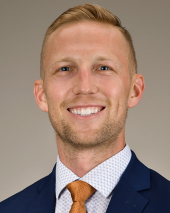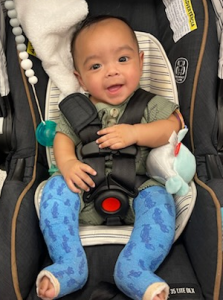The diagnosis of clubfoot during a routine 20-week ultrasound would be surprising for most moms, but especially for a first-time mom. That was the experience for Evelyn Gutierrez, when she discovered her baby-to-be, Jazael Gamboa-Gutierrez, had feet that turned inward.
“When I found out, I was very scared. The first thing in my head was, ‘Is something wrong with my baby,” Evelyn said. “I think that’s the first thing all mothers would think. And, would it be something he has to deal with for the rest of his life?”
Clubfoot is a common birth defect that affects the alignment of the bones in the foot. A clubfoot turns in with toes pointing toward the other leg. Jazael was born with clubfoot in both feet, or bilateral clubfoot. This affects up to 1 in 1,000 natural births.
A path to healing

Still in the hospital, Evelyn started making calls searching for a clubfoot specialist. She learned in her research that the sooner she could get Jazael into treatment, the better the outcome. She found Brennan Roper, MD, a UT Physicians pediatric and adolescent orthopedic surgeon who treats clubfoot.
Jazael first visited Roper when he was three weeks old. Roper said part of the visit was calming Evelyn’s fears about clubfoot and all the things she read online that were concerning to her, such as long-term problems and potential surgeries throughout his life. They did a full head-to-toe assessment, as usual with all newborns who come to the clinic. Roper said Jazael looked perfectly fine, other than the bilateral clubfoot deformity. The nice thing about clubfoot, he said, is it can be corrected pretty quickly if appropriate therapy is started early on.

“I like to get them started around two to three weeks of age, and each week we take them through progressive casting,” said Roper, assistant professor in the Department of Orthopedic Surgery at McGovern Medical School at UTHealth Houston. “We try to correct specific deformities within the clubfoot diagnosis each week and make progressive changes until the foot is in an acceptable position.”
Jazael had seven weeks of casting, which entailed a full cast from toe to groin on both legs. Roper said they use full casts to prevent babies from wiggling out. He then transitioned Jazael to braces, which have to continually be resized as his foot grows.
Treatment for clubfoot is a series of casts and then braces, sometimes called boots and bars. Babies wear the braces (boots or shoes connected with a metal bar) full time for three to six months, and then wear them only while they sleep during naps and nighttime until age four or five. Children with clubfoot usually don’t experience any delayed milestones with crawling or walking.
“Most of these kids are into braces by about three or four months, so when they’re starting to crawl, they should be reaching part-time bracing,” Roper said. “During the day they are able to crawl, sit, stand, and walk like other kids. Bracing is worn at night.”
Next steps

Therapy and stretching are a big component of treatment for clubfoot. Roper describes the team who works with the clubfoot patients and strongly believes it contributes to their success. Patients work with a specific therapist and the same cast tech each week, so Roper and the team see them on a weekly basis during the serial casting phase. Jazael continues going to therapy every three weeks to help with the positioning of his feet and standing correctly. His mom also performs daily stretching exercises to keep his feet corrected, as well.
Catching clubfoot early on and getting started with a consistent team are the most important aspects of a successful treatment, according to Roper. Jazael has maintained his correction really well, without needing a tenotomy (cutting the Achilles tendon for final correction), which is a huge win. Every baby with clubfoot is a little different regarding the number of casts and need for a tenotomy.
“Ninety percent of these kids end up needing a tenotomy, so it was rare in his case not to need one. Jazael corrected so well in the cast that he didn’t need that,” Roper said. “That’s really cool for him – and mom, because she was obviously apprehensive about that.”
Roper described Jazael as a happy baby who is very interactive with the exam. He hated the stretches, just like most babies, but he tolerated casting really well, he said.
Evelyn appreciated Roper’s encouragement and his caring nature with kids.
“He’s the type that says, ‘You’re doing amazing, you’re on the right path’ even though you have so many uncertainties of what’s going on with your child,” she said. “He reassured us a lot and made sure we knew that everything was fine.”
Future aspects

A critical aspect of treatment for clubfoot is ensuring consistent follow up. Roper said staying in the braces will be the biggest challenge for Jazael, moving forward.
“As he gets a little older and develops his individual personality, he doesn’t always want to keep those braces on,” Roper said. “But the best way to prevent recurrence from happening is making sure he keeps them on.”
Based on Evelyn’s journey with Jazael, she shares advice for anyone going through the same experience: “If I was reading a story about this and was a mom of a clubfoot child, I would want the moms to know it’s not something to be scared of. Your next thought is, ‘What’s going on? What am I doing?’ Moms should know it’s not scary.”


